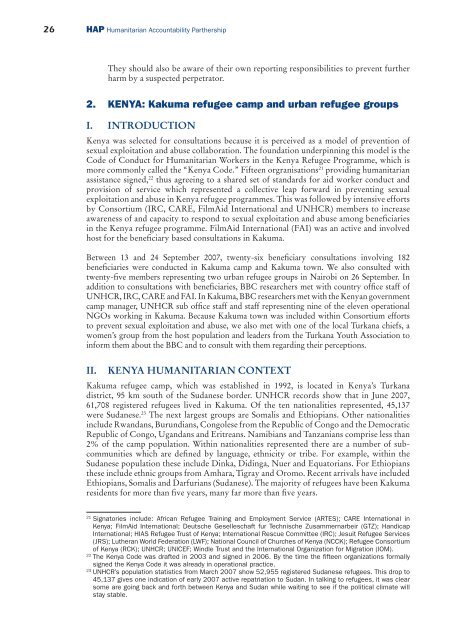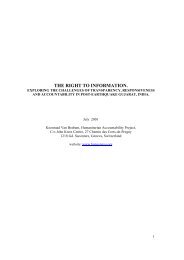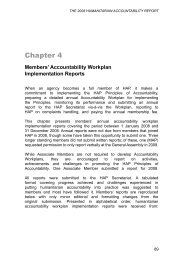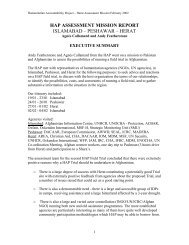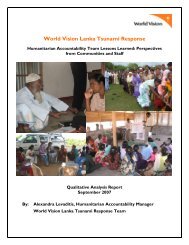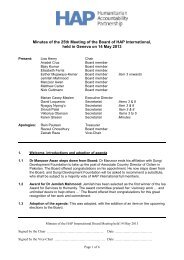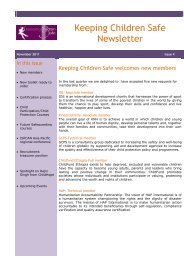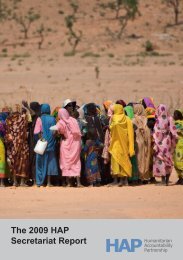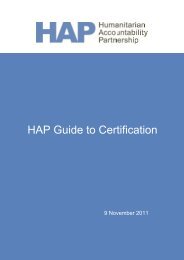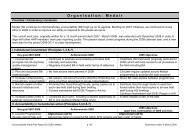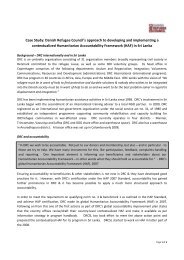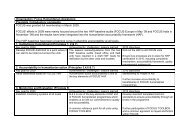TO COMPLAIN OR NOT TO COMPLAIN: STILL THE QUESTION ...
TO COMPLAIN OR NOT TO COMPLAIN: STILL THE QUESTION ...
TO COMPLAIN OR NOT TO COMPLAIN: STILL THE QUESTION ...
Create successful ePaper yourself
Turn your PDF publications into a flip-book with our unique Google optimized e-Paper software.
26 HAP Humanitarian Accountability Parthership<br />
They should also be aware of their own reporting responsibilities to prevent further<br />
harm by a suspected perpetrator.<br />
2. KENYA: Kakuma refugee camp and urban refugee groups<br />
I. INTRODUCTION<br />
Kenya was selected for consultations because it is perceived as a model of prevention of<br />
sexual exploitation and abuse collaboration. The foundation underpinning this model is the<br />
Code of Conduct for Humanitarian Workers in the Kenya Refugee Programme, which is<br />
more commonly called the “Kenya Code.” Fifteen orgranisations 21 providing humanitarian<br />
assistance signed, 22 thus agreeing to a shared set of standards for aid worker conduct and<br />
provision of service which represented a collective leap forward in preventing sexual<br />
exploitation and abuse in Kenya refugee programmes. This was followed by intensive efforts<br />
by Consortium (IRC, CARE, FilmAid International and UNHCR) members to increase<br />
awareness of and capacity to respond to sexual exploitation and abuse among beneficiaries<br />
in the Kenya refugee programme. FilmAid International (FAI) was an active and involved<br />
host for the beneficiary based consultations in Kakuma.<br />
Between 13 and 24 September 2007, twenty-six beneficiary consultations involving 182<br />
beneficiaries were conducted in Kakuma camp and Kakuma town. We also consulted with<br />
twenty-five members representing two urban refugee groups in Nairobi on 26 September. In<br />
addition to consultations with beneficiaries, BBC researchers met with country office staff of<br />
UNHCR, IRC, CARE and FAI. In Kakuma, BBC researchers met with the Kenyan government<br />
camp manager, UNHCR sub office staff and staff representing nine of the eleven operational<br />
NGOs working in Kakuma. Because Kakuma town was included within Consortium efforts<br />
to prevent sexual exploitation and abuse, we also met with one of the local Turkana chiefs, a<br />
women’s group from the host population and leaders from the Turkana Youth Association to<br />
inform them about the BBC and to consult with them regarding their perceptions.<br />
II.<br />
KENYA HUMANITARIAN CONTEXT<br />
Kakuma refugee camp, which was established in 1992, is located in Kenya’s Turkana<br />
district, 95 km south of the Sudanese border. UNHCR records show that in June 2007,<br />
61,708 registered refugees lived in Kakuma. Of the ten nationalities represented, 45,137<br />
were Sudanese. 23 The next largest groups are Somalis and Ethiopians. Other nationalities<br />
include Rwandans, Burundians, Congolese from the Republic of Congo and the Democratic<br />
Republic of Congo, Ugandans and Eritreans. Namibians and Tanzanians comprise less than<br />
2% of the camp population. Within nationalities represented there are a number of subcommunities<br />
which are defined by language, ethnicity or tribe. For example, within the<br />
Sudanese population these include Dinka, Didinga, Nuer and Equatorians. For Ethiopians<br />
these include ethnic groups from Amhara, Tigray and Oromo. Recent arrivals have included<br />
Ethiopians, Somalis and Darfurians (Sudanese). The majority of refugees have been Kakuma<br />
residents for more than five years, many far more than five years.<br />
21<br />
Signatories include: African Refugee Training and Employment Service (ARTES); CARE International in<br />
Kenya; FilmAid International; Deutsche Geselleschaft fur Technische Zusammernarbeir (GTZ); Handicap<br />
International; HIAS Refugee Trust of Kenya; International Rescue Committee (IRC); Jesuit Refugee Services<br />
(JRS); Lutheran World Federation (LWF); National Council of Churches of Kenya (NCCK); Refugee Consortium<br />
of Kenya (RCK); UNHCR; UNICEF; Windle Trust and the International Organization for Migration (IOM).<br />
22<br />
The Kenya Code was drafted in 2003 and signed in 2006. By the time the fi fteen organizations formally<br />
signed the Kenya Code it was already in operational practice.<br />
23<br />
UNHCR’s population statistics from March 2007 show 52,955 registered Sudanese refugees. This drop to<br />
45,137 gives one indication of early 2007 active repatriation to Sudan. In talking to refugees, it was clear<br />
some are going back and forth between Kenya and Sudan while waiting to see if the political climate will<br />
stay stable.


